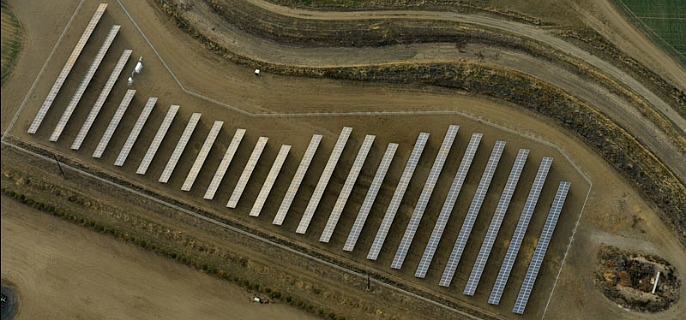
PHOTO COURTESY OF OREGON STATE UNIVERSITY
Oregon State University this spring has brought the largest of its ground-mounted solar arrays online as part of the Oregon University System’s “Solar by Degrees” program.
OSU had previously completed a solar site at the Hermiston Agricultural Research and Experiment Station (HAREC).
The university now has three solar project sites in Corvallis covering some 10 acres collectively that have the capacity to generate more than 2.6 million kilowatt-hours of power per year. The system not only provides cost savings by providing solar energy for less than current utility power rates, it helps Oregon State reduce its carbon footprint in a way that doesn’t cost the university money up front.
The arrays were constructed and are owned and operated by SolarCity, which has worked with OSU and the Oregon Institute of Technology for several years on the Solar by Degrees programs. The company’s collaboration with OSU has not been limited to the Corvallis campus, according to Brandon Trelstad, the university’s sustainability coordinator.
“The way the partnership works is that SolarCity installs the solar arrays at no cost to the university, and OSU simply pays for solar energy that they produce – at a lower rate than they would pay for utility power,” Trelstad said.
This past fall, SolarCity completed a 431-kilowatt installation at OSU’s HAREC in Eastern Oregon, and another 221-kilowatt solar project at the North Willamette Research and Extension Center in Aurora. Annual electrical output from all five OSU solar sites is approximately equivalent to the annual carbon emissions from 255,025 gallons of gasoline or 477 passenger vehicles, according to US Environmental Protection Agency’s Greenhouse Gas Equivalencies Calculator.
“This is another step toward meeting OSU’s aggressive carbon emissions reduction targets,” Trelstad said. “It also saves the university money and provides some unique research and educational opportunities. Advancements like Solar by Degrees don’t come along often and I’m glad that OSU has been able to maximize our use of the groundwork laid by the Oregon University System.”
Two of the sites in Corvallis have operated for more than a year, but the latest site in Corvallis – which is located near 35th Street and Campus Way – just went online. Each installation is “grid-tied,” which means it seamlessly provides power when the sun shines and blends in utility power when it doesn’t.
At the branch Experiment Stations, the arrays not only save money, they provide an example of how solar power can work in a rural and/or agricultural setting.
“The solar array at Hermiston is expected to reduce our electricity costs by about half – a savings of about $30,000 in the first year and could increase in the future depending on electricity costs,” said Philip B. Hamm, director of the Hermiston Agricultural Research and Experiment Station.
“This allows us to provide more financial support toward our mission, which is to provide new research-based information to clients.”
Michael Bondi, director of the North Willamette Research and Extension Center located just south of Wilsonville, said the center at the end of February received its first electrical utility bill since the project was launched.
“For that month, we reduced our cost from the previous year by 50 percent,” Bondi said. “I like how that looks, especially in the middle of winter and a lot of gray days. Based on the design specs for the project, we expect to reduce our electrical usage from the grid by 80 to 85 percent each year.
“I’d say we are well on the way to that goal.”
“This will likely be the largest scale installations we complete here,” said Trelstad. “However, over the next few years, we will look for additional opportunities to install solar panels on roofs since we already have used much of the compatible ground space.”
At two of the three Corvallis installations, the College of Agricultural Sciences is grazing sheep next to the solar arrays, which is how the land previously was used. “This is a great way to optimize land use and not consume productive ground solely with solar installations,” Trelstad noted.
At the Aurora location, a bee and insect pollinator habitat area is being planned. At the Hermiston location, the area had never been used for research given its irregular shape and lack of water availability, but now benefits the campus to provide solar power in an otherwise unusable space.
More information on the arrays, including photos and electricity production information, is available on the OSU website.
More Stories from Northeast Oregon Now:
Permit Process Holding Up Pacific Morrow Project
Fish for Free in Oregon on June 7-8








